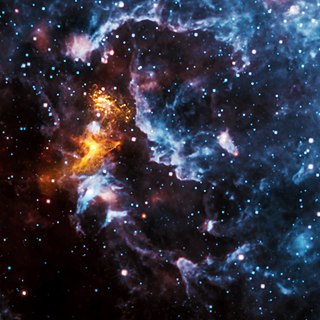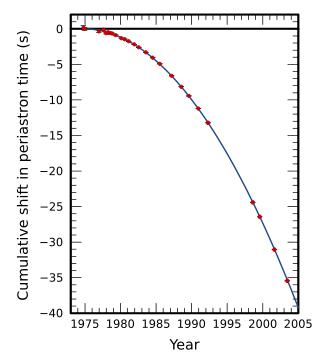Related Research Articles

A neutron star is the collapsed core of a massive supergiant star. It results from the supernova explosion of a massive star—combined with gravitational collapse—that compresses the core past white dwarf star density to that of atomic nuclei. Except for black holes, neutron stars are the smallest and densest known class of stellar objects. They have a radius on the order of 10 kilometers (6 mi) and a mass of about 1.4 M☉. Stars that collapse into neutron stars have a total mass of between 10 and 25 solar masses (M☉), or possibly more for those that are especially rich in elements heavier than hydrogen and helium.
PSR B1257+12, previously designated PSR 1257+12, alternatively designated PSR J1300+1240, is a millisecond pulsar located 2,300 light-years from the Sun in the constellation of Virgo, rotating at about 161 times per second. It is also named Lich, after a powerful, fictional undead creature of the same name.

A pulsar is a highly magnetized rotating neutron star that emits beams of electromagnetic radiation out of its magnetic poles. This radiation can be observed only when a beam of emission is pointing toward Earth, and is responsible for the pulsed appearance of emission. Neutron stars are very dense and have short, regular rotational periods. This produces a very precise interval between pulses that ranges from milliseconds to seconds for an individual pulsar. Pulsars are one of the candidates for the source of ultra-high-energy cosmic rays.

Andrew Geoffrey Lyne is a British physicist. Lyne is Langworthy Professor of Physics in the School of Physics and Astronomy, University of Manchester, as well as an ex-director of the Jodrell Bank Observatory. Despite retiring in 2007 he remains an active researcher within the Jodrell Bank Pulsar Group. Lyne writes that he is "mostly interested in finding and understanding radio pulsars in all their various forms and with their various companions. Presently, I am most occupied with the development of new multibeam search systems at Jodrell and Parkes, in order to probe deeper into the Galaxy, particularly for millisecond pulsars, young pulsars and any that might be in binary systems."

A millisecond pulsar (MSP) is a pulsar with a rotational period less than about 10 milliseconds. Millisecond pulsars have been detected in radio, X-ray, and gamma ray portions of the electromagnetic spectrum. The leading hypothesis for the origin of millisecond pulsars is that they are old, rapidly rotating neutron stars that have been spun up or "recycled" through accretion of matter from a companion star in a close binary system. For this reason, millisecond pulsars are sometimes called recycled pulsars.

PSR J0737−3039 is the first known double pulsar. It consists of two neutron stars emitting electromagnetic waves in the radio wavelength in a relativistic binary system. The two pulsars are known as PSR J0737−3039A and PSR J0737−3039B. It was discovered in 2003 at Australia's Parkes Observatory by an international team led by the Italian radio astronomer Marta Burgay during a high-latitude pulsar survey.

The Hulse–Taylor pulsar is a binary star system composed of a neutron star and a pulsar which orbit around their common center of mass. It is the first binary pulsar ever discovered.

A binary pulsar is a pulsar with a binary companion, often a white dwarf or neutron star. Binary pulsars are one of the few objects which allow physicists to test general relativity because of the strong gravitational fields in their vicinities. Although the binary companion to the pulsar is usually difficult or impossible to observe directly, its presence can be deduced from the timing of the pulses from the pulsar itself, which can be measured with extraordinary accuracy by radio telescopes.

The Vela Pulsar is a radio, optical, X-ray- and gamma-emitting pulsar associated with the Vela Supernova Remnant in the constellation of Vela. Its parent Type II supernova exploded approximately 11,000–12,300 years ago.
The Tolman–Oppenheimer–Volkoff limit is an upper bound to the mass of cold, non-rotating neutron stars, analogous to the Chandrasekhar limit for white dwarf stars. Stars more massive than the TOV limit collapse into a black hole. The original calculation in 1939, which neglected complications such as nuclear forces between neutrons, placed this limit at approximately 0.7 solar masses (M☉). Later, more refined analyses have resulted in larger values.
PSR J0537-6910 is a pulsar that is 4,000 years old. It is located about 170,000 light-years away, in the southern constellation of Dorado, and is located in the Large Magellanic Cloud. It rotates at 62 hertz.

PSR B1257+12 b, alternatively designated PSR B1257+12 A, also named Draugr, is an extrasolar planet approximately 2,300 light-years (710 pc) away in the constellation of Virgo. The planet is the innermost object orbiting the pulsar Lich, making it a pulsar planet in the dead stellar system. It is about twice as massive as the Moon, and is listed as the least massive planet known, including among the planets in the Solar System.

PSR B1257+12 c, alternatively designated PSR B1257+12 B, also named Poltergeist, is an extrasolar planet approximately 2,300 light-years away in the constellation of Virgo. It was one of the first planets ever discovered outside the Solar System, and is one of three pulsar planets known to be orbiting the pulsar Lich.

PSR B1257+12 C, alternatively designated PSR B1257+12 d and also named Phobetor, is a super-Earth exoplanet orbiting the pulsar Lich approximately 2,315 light-years away from Earth in the constellation of Virgo. It was one of the first planets ever discovered outside the Solar System. It was discovered using the pulsar timing method, where the regular pulses of a pulsar are measured to determine if there is a planet causing variations in the data.
PSR J1903+0327 is a millisecond pulsar in a highly eccentric binary orbit.

PSR B1937+21 is a pulsar located in the constellation Vulpecula a few degrees in the sky away from the first discovered pulsar, PSR B1919+21. The name PSR B1937+21 is derived from the word "pulsar" and the declination and right ascension at which it is located, with the "B" indicating that the coordinates are for the 1950.0 epoch. PSR B1937+21 was discovered in 1982 by Don Backer, Shri Kulkarni, Carl Heiles, Michael Davis, and Miller Goss.
PSR J0108−1431 is a solitary pulsar located at a distance of about 130 parsecs (424 light-years) in the constellation Cetus. This pulsar was discovered in 1994 during the Parkes Southern Pulsar Survey. It is considered a very old pulsar with an estimated age of 166 million years and a rotation period of 0.8 seconds. The rotational energy being generated by the spin-down of this pulsar is 5.8 × 1023 W and the surface magnetic field is 2.5 × 107 T. As of 2008, it is the second faintest known pulsar.
PSR J1614–2230 is a pulsar in a binary system with a white dwarf in the constellation Scorpius. It was discovered in 2006 with the Parkes telescope in a survey of unidentified gamma ray sources in the Energetic Gamma Ray Experiment Telescope catalog. PSR J1614–2230 is a millisecond pulsar, a type of neutron star, that spins on its axis roughly 317 times per second, corresponding to a period of 3.15 milliseconds. Like all pulsars, it emits radiation in a beam, similar to a lighthouse. Emission from PSR J1614–2230 is observed as pulses at the spin period of PSR J1614–2230. The pulsed nature of its emission allows for the arrival of individual pulses to be timed. By measuring the arrival time of pulses, astronomers observed the delay of pulse arrivals from PSR J1614–2230 when it was passing behind its companion from the vantage point of Earth. By measuring this delay, known as the Shapiro delay, astronomers determined the mass of PSR J1614–2230 and its companion. The team performing the observations found that the mass of PSR J1614–2230 is 1.97 ± 0.04 M☉. This mass made PSR J1614–2230 the most massive known neutron star at the time of discovery, and rules out many neutron star equations of state that include exotic matter such as hyperons and kaon condensates.
PSR B0943+10 is a pulsar 2,000 light years from Earth in the direction of the constellation of Leo. It was discovered at Pushchino in December 1968, becoming the first pulsar discovered by Soviet astronomers. The original designation of this pulsar was PP 0943

Pulsar planets are planets that are orbiting pulsars. The first such planets to be discovered were around a millisecond pulsar in 1992 and were the first extrasolar planets to be confirmed as discovered. Pulsars are extremely precise clocks and even small planets can create detectable variations in pulsar traits; the smallest known exoplanet is a pulsar planet.
References
- ↑ Smith, D. A.; Guillemot, L.; Camilo, F.; Cognard, I.; et al. (2008). "Pulsar timing for the Fermi gamma-ray space telescope". Astronomy and Astrophysics. 492 (3): 923–931. arXiv: 0810.1637 . Bibcode:2008A&A...492..923S. doi:10.1051/0004-6361:200810285. S2CID 119200759.
- 1 2 "PSR B1828-10 -- Pulsar". SIMBAD. Retrieved 2014-07-02.
- ↑ Bailes, M.; Lyne, A. G.; Shemar, S. L. (1993). "Limits on pulsar planetary systems from the Jodrell Bank timing database". Planets around pulsars; Proceedings of the Conference. California Inst. of Technology, Pasadena. pp. 19–30. Bibcode:1993ASPC...36...19B.
- ↑ Stairs, I. H.; Lyne, A. G.; Shemar, S. L. (2000). "Evidence for free precession in a pulsar". Nature. 406 (6795): 484–486. Bibcode:2000Natur.406..484S. doi:10.1038/35020010. PMID 10952302. S2CID 4415709.
- ↑ Link, Bennett; Epstein, Richard I. (2001). "Precession Interpretation of the Isolated Pulsar PSR B1828-11". The Astrophysical Journal. 556 (1): 392–398. arXiv: astro-ph/0101434 . Bibcode:2001ApJ...556..392L. doi:10.1086/321581. S2CID 118948361.
- ↑ Akgün, Taner; Link, Bennett; Wasserman, Ira (2006). "Precession of the isolated neutron star PSR B1828-11". Monthly Notices of the Royal Astronomical Society. 365 (2): 653–672. arXiv: astro-ph/0506606 . Bibcode:2006MNRAS.365..653A. doi: 10.1111/j.1365-2966.2005.09745.x . S2CID 14390165.
- ↑ Liu; et al. (2007). "PSR B1828-11: a precession pulsar torqued by a quark planet?". Monthly Notices of the Royal Astronomical Society: Letters . 381 (1): L1–L5. arXiv: astro-ph/0411133 . Bibcode:2007MNRAS.381L...1L. doi: 10.1111/j.1745-3933.2007.00337.x . S2CID 119405995.